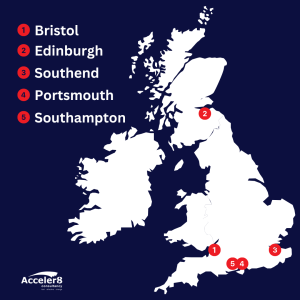Remote working’s state in the modern workplace
As we all know, since the start of the COVID-19 pandemic in March 2020, the number of people working from home in the UK has dramatically increased. That is no surprise, and here are some stats that paint a picture. During the pandemic, a staggering 46.6% of employed people did some work at home. Since then, 44% of UK employees have continued to work from home, either fully or hybrid. With 52% of business leaders surveyed believing that hybrid working is the most supportive environment for employee productivity, what’s remote working’s state in the workplace now?
John Potamianos, Director of Acceler8 Consultancy, takes us through the pros and cons he sees of remote working and where he believes the future lies.
What are the proven benefits of remote working?
There are more people working from home than ever, whether or not by choice. There are a number of advantages to homeworking in the UK, according to participants of The Home Office Life survey:
- The main benefit is flexible scheduling, according to 50% of respondents
- The second main benefit is a lack of commute, according to 43% of respondents, saving stress and time that can be put to other uses
- 34% find that working from home allows them to look after family, pets, ageing or unwell relatives better
- 25% cited improved health, whether it’s mental, physical or spiritual
- 18% state that homeworking gives them the freedom to travel or relocate entirely
Top cities for remote workers
Personnel Checks have released their latest data highlighting the top UK cities for remote workers in 2024. To determine results, they consulted multiple data sources, looking at the most populous cities, using data from sources like Centre for Cities for population stats, Ofcom for broadband and mobile data, ONS for working age population and access to green spaces, WHO for air quality, and TripAdvisor for the number of cafes and coffee shops.
Each city was scored from 1 to 25 across these categories, leading to a final ranking that gives a clear picture of where remote workers might find their next best spot. And here are the top five…
Other cities featured in the top 25 list included Bournemouth in 6th place, Northampton in 7th, Brighton in 8th, Reading in at 9th, and Swansea coming into the 10th spot. Just making the list is Manchester and Newcastle in spots 24 and 25.
What does the future of remote working look like?
Putting wellbeing first
According to the Social Connection in Remote Work survey, remote workers have reported increased feelings of loneliness. The stats shows that 68% of employees say that social connection during the workday is at least somewhat important. But 55% of people still feel lonely at least some of the time. So, where remote working is “part of the job,” employers should put employee wellbeing at the forefront of their operations to combat employee isolation and loneliness.
Rise of freelancers
As companies have become more secure with their hybrid workforce, they have been increasingly turning to freelance platforms. This comes at a time when millions of people are seeking out remote freelance work for the first time. According to Harvard Business School research, nearly half of senior corporate executives expect to use digital talent platforms substantially more in the future.
Employee surveillance with ‘bossware’
With employees working away from the office, there is a growing debate about whether workers are focused on work or whether other distractions get in the way. Terms like “work shy” or “slackers” are emerging. Though there may be such cases it is unhelpful to label all people with one overly broad and negative brush. To address this, some managers are turning to technology to keep an eye on employee productivity and efficiency. After a surge in employee monitoring software during the pandemic, this type of tech has become known as “bossware.” A survey from September 2022 reported that 60% of employers now require employees to have this type of monitoring software installed on their devices.
In addition, 17% of employers are considering implementing these types of solutions. Some software takes random screenshots, some record mouse movements, and some log keystrokes. This comes with the danger of creating a surveillance and therefor low trust culture. An alternative approach is to move from measuring input to measuring output. If an employee takes an hour break to go for a quick run or walk in the middle of the day and comes back with a clearer head, making up time and delivering better output, why would management want to stop this?
Fairness when some jobs require physical presence
The stats for remote working are limited by the fact that some jobs require employees to be physically present. These jobs cut across all walks of life, form surgeons, judges and pilots to nurses, drivers, cleaners, emergency workers, shop assistants, mechanics, and the list goes on. So, in a business where a vast number of its employees does not have this choice, is it equitable to give some employees this choice? But then is treating everyone the same actually equalising or is it another broad brush?
Each organisation has to establish what culture it believes is best for its customers, its people, and its success. A broad-brush approach rarely delivers that. Fairness is a critical contributing factor to having a healthy work environment ad culture. Creating a conversation and understanding between different employee groups is the start. Finding ways where when one “perk” is available to one group of employees then another “perk” can be offered to another group to create fairness can actually create a more optimal productivity balance between job roles that can and cannot accommodate remote working.
So, what does the future of remote working look like?
Since the initial boom of remote working during the pandemic, it is never really cooled off. Businesses need to take a note of future trends of remote working as it’s clear, it’s not slowing down. As a substantial proportion of the UK’s workforce have been remote for a few years, it is important for employers and managers to ensure their teams are connected, communicating, and collaborating, to mitigate isolation and loneliness. Broad-brush rules or approaches that enforce things will reduce trust and lead to the best talent finding other more favourable options. There is no doubt that in a few years we will have a whole new set of remote working trends and future predictions, and possibly a new unique way of working. And we will also see the benefits of giving something to employee groups that cannot work remotely.








